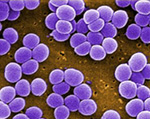
Staph aureus bacteria greatly magnified (Credit: Arduino/CDC)
There’s a fair amount of confusion online about what MRSA really is. Sometimes you’ll see it called MERSA, Staph MRSA, resistant Staph, Staph superbug, or even MRSA Virus.
What is MRSA? Is it a virus? Is it a bacteria? What exactly is it?
You’ve probably seen the media misquote MRSA as the “MRSA-virus”. Viruses are responsible for colds and flu, not bacterial infections like MRSA.
MRSA stands for “Methicillin Resistant Staphylococcus aureus “. It’s actually a type of bacteria known as “Staphylococcus aureus ” (or “Staph”) that is resistant to certain types of antibiotics. That’s why sometimes it’s called Staph MRSA. Simply put, MRSA is a bacteria that is immune or resistant to many kinds of antibiotics. MRSA has been getting resistant to more types of antibiotics over time.
There are many reasons why this bacteria is becoming more resistance to antibiotics. When antibiotics are prescribed for viral infections like colds and flu, bacteria learn to become resistant to the drugs. See this article for common MRSA survival strategies. MRSA is also a common contaminant in meat (see antibiotic resistant Staph found in meat).
MRSA infections are not limited to hospitals anymore
In the past, MRSA infections were spread to people in hospitals through surgeries or other procedures. These bacteria have to get through your skin (through cuts, scrapes, surgical incisions, etc) to cause an infection. So, if a surgical wound is contaminated with these bacteria, a MRSA infection could result.
MRSA is also becoming more common in communities. These bacteria are being transferred from person to person in gyms, schools, and grocery stores. Anyplace where there are people, this bacteria can live and be transferred through direct touch and through the air. To learn more about carrying MRSA and how it spreads, here’s some more helpful information: what is a carrier and how contagious is MRSA.
MRSA infections can range from skin infections, to sinus or eye infections, and also internal infections like bone infections, septicemia, heart infections and more. Common treatments include antibiotic drugs, however most broad-spectrum antibiotics will not work against MRSA and can even make it grow stronger. There are also natural products that are effective against MRSA Staph.
Are all bacteria are bad?
Staph aureus bacteria are common on people’s skin, in fact, around 30% of all people in the world harbor Staph aureus (I’m actually one of them). But, just because you carry Staph doesn’t mean you’ll get an infection. Bacteria like Staph and many others live on your skin and inside your digestive system. Most of these bacteria help you to stay healthy and don’t make you sick. These beneficial bacteria actually protect you from “bad” bacterial, yeast or viral infections and they also help you digest vitamins and other important nutrients.
The use of antibiotics and some natural treatments reduces the numbers of “good” bacteria and this can make you much more vulnerable to future infections. Be sure to consider a good probiotic as part of your treatment approach.
To your best health,
Michelle Moore
Microbiologist and Natural Health Advocate
Author of the Natural Staph and MRSA recovery program MRSA Secrets Revealed.
My book is a comprehensive guidebook on effective natural methods to help stop MRSA and Staph infections. It also includes a holistic approach to supporting your body to remove infection and in-depth ways to fortify your immune system.




